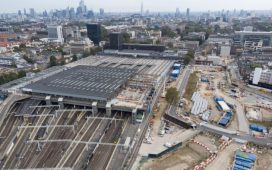Stay informed with free updates
Simply sign up to the UK house prices myFT Digest — delivered directly to your inbox.
UK house prices rose for a second month in November, according to mortgage provider Halifax, in further evidence of a resilient property market despite the stuttering broader economy.
Prices rose 0.5 per cent between October and November, following a 1.2 per cent increase in the previous month, Halifax said.
A typical UK home cost £283,615, 1 per cent down from November last year but still some £44,000 more than in January 2020, before the pandemic.
House prices have been declining since summer last year, reflecting the impact of higher interest rates and a stagnating economy. However, the latest figures released over the past two weeks suggest activity and prices stabilised in the autumn on expectations that the Bank of England’s benchmark interest rate had peaked and could be cut from the middle of next year, easing pressure on mortgage rates.
Separate data published by the BoE last week showed that two-year fixed mortgage rates with a 60 per cent loan-to-value ratio eased from 6.2 per cent in July to 5.5 per cent in October. It also showed that mortgage approvals increased more than expected to a three-month high in October.
Last week, mortgage provider Nationwide reported UK house prices rose for the third consecutive month in November.
Kim Kinnaird, director at Halifax Mortgages, said that despite the economic headwinds, property prices “have held up better than expected” in 2023.
He noted that “the resilience seen in house prices during 2023 continues to be underpinned by a shortage of properties available, rather than any significant strengthening of buyer demand”.
With mortgage rates starting to ease slightly, “this may be leading to increased buyer confidence, seeing people more inclined to push ahead with their home purchases”, he added.
The BoE’s Monetary Policy Committee held interest rates unchanged at a 15-year high of 5.25 per cent at its previous two meetings, ending 14 consecutive increases from an all-time record low of 0.1 per cent. Markets are pricing that the bank will start cutting rates by the middle of next year.
William Page, head of global sales at global property consultants IP Global, said most of 2023 was “defined by hesitation, but that has now passed and is being replaced with confidence as concerns about major price drops have eased”.

Northern Ireland was the strongest-performing nation or region in the UK, with house prices increasing 2.3 per cent on an annual basis, according to Halifax. It was followed by Scotland where prices were unchanged from last year.
The South East was the region with the sharpest fall in prices, contracting at an annual pace of 5.7 per cent. London continued to be the most expensive property market in the country, with the average price at £524,592, although prices in the capital fell 3.8 per cent in the 12 months to November.
Kinnaird said that with the cost of living crisis continuing and many properties remaining unaffordable, he expected “to see downward pressure on house prices into next year”.
But Tom Bill, head of UK residential research at estate agent Knight Frank, said the stabilisation seen in recent data could mark the bottom of the current housing market slowdown, or “we must be close”.











